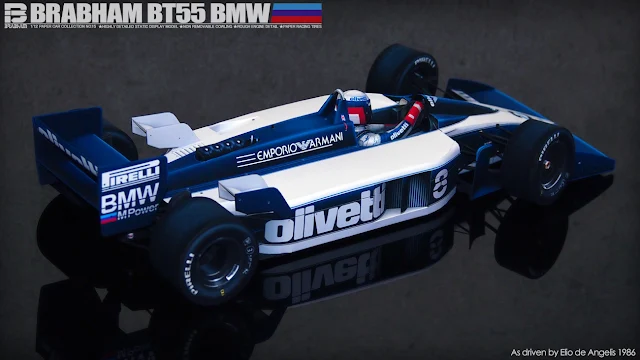Rebuilding History: The BMW Brabham BT55 Formula One and Its Papercraft Revival
History of the BMW Brabham BT55 Formula One
 |
| The BMW Brabham BT55 Formula One Papermodel by Sunny78 |
The BMW Brabham BT55 is a significant car in the world of Formula One, not only for its innovative design but also for the dramatic story surrounding its development. Created for the 1986 F1 season, the BT55 was the brainchild of legendary designer Gordon Murray, who aimed to revolutionize car aerodynamics with a bold, low-profile design. Although it promised great potential, the BT55 became one of Formula One’s most intriguing but tragic stories.
The Concept Behind the BT55
In the mid-1980s, Formula One was undergoing rapid technological advancements, and aerodynamics was at the forefront of car design evolution. Gordon Murray, working with the Brabham team, had already gained a reputation as a forward-thinking designer. His vision for the BT55 was simple but groundbreaking: to create a car with a lower center of gravity and better aerodynamics than anything else on the grid.To achieve this, Murray designed the BT55 to be incredibly low, earning it the nickname "the skateboard." By reducing the car's height, the theory was that airflow over the car would create less drag, boosting both speed and cornering ability. However, this radical design came with a unique challenge—Murray had to lay the engine almost completely flat, which required BMW to redesign their turbocharged 4-cylinder engine for a more horizontal orientation.
Performance Struggles
While the concept of the BT55 was groundbreaking, the car’s performance did not match its ambition. The flat engine design caused reliability issues, particularly with oil and fuel delivery. The engine also suffered from a turbo lag, which hindered the drivers from getting the most out of the car in terms of power and acceleration.
Furthermore, the BT55’s design made it incredibly difficult to drive. Nelson Piquet, Brabham’s star driver in previous years, had moved to Williams by 1986, leaving Riccardo Patrese and Elio de Angelis to pilot the BT55. Both drivers struggled to control the car’s unpredictable handling.The tragedy struck in May 1986, when Elio de Angelis tragically lost his life in a testing crash in the BT55 at Paul Ricard Circuit. The accident was not due to a car failure, but it underscored the challenges faced by the team. The BT55 only managed a few points finishes throughout the season, and by the end of 1986, the Brabham team abandoned the design concept.
Legacy
Though the BT55 was unsuccessful in terms of results, its low-profile concept influenced future designs in Formula One. Gordon Murray’s aerodynamic principles lived on, and many of the innovations he introduced with the BT55 were refined by other teams in later years. The car remains a fascinating chapter in the history of Formula One, representing both the triumph of engineering ambition and the realities of pushing the limits of technology.
BMW Brabham BT55 Formula One Papercraft by Sunny78
For Formula One enthusiasts and papercraft hobbyists, the BMW Brabham BT55 papercraft model designed by Sunny78 offers an opportunity to recreate a piece of motorsport history in paper form. This model captures the sleek, low-profile design of the BT55, allowing you to appreciate the car's innovative yet challenging form firsthand.
About the Papercraft Model
Sunny78’s papercraft version of the BMW Brabham BT55 is a highly detailed and accurate representation of the actual Formula One car. The model features all the key aspects of the BT55’s design, including the ultra-low chassis, the distinctive flat engine setup, and the detailed aerodynamic components like the wings and side pods.
Skill Level: The model is suitable for intermediate to advanced papercrafters. While it’s a challenging build due to its intricate design and detailed parts, the end result is a rewarding display piece for any Formula One fan.
Instructions and Download Link
To get started on building the BMW Brabham BT55 papercraft model, follow these simple steps:
Download the template: The papercraft template can be downloaded from this Google Drive link.
Read the Terms of Use: Before downloading and building the model, make sure to review the designer’s terms of use. You can access the terms by visiting this link. The terms will also provide you with a password that you need to open the template file.
Prepare your materials: Print the template on high-quality cardstock for durability. You’ll also need scissors, a craft knife, glue, and a ruler to complete the model.
Building Tips
- Patience and precision: This model contains small, delicate parts that require careful cutting and assembly. Take your time, especially when working on the chassis and aerodynamic components.
- Use a sharp knife: A sharp craft knife is essential for achieving clean, accurate cuts on the smaller parts of the model.
- Follow the instructions carefully: The model comes with detailed instructions. Be sure to follow them step by step to avoid mistakes.
Displaying the Model
Once completed, the BMW Brabham BT55 papercraft makes for an impressive display piece. It captures the essence of the car's unique design and serves as a conversation starter for Formula One history enthusiasts. Whether you're a fan of Gordon Murray’s engineering or simply appreciate classic F1 cars, this model is a great way to commemorate the legendary but short-lived BT55.
The BMW Brabham BT55 Formula One papercraft model designed by Sunny78 offers an exciting and challenging project for motorsport fans. With its intricate design and historical significance, it’s more than just a craft—it’s a tribute to one of Formula One’s most fascinating cars.


















